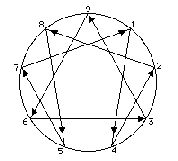
The enneagram is a diagram of how perpetual motion might be pictured. It represents the interplay of that which appears as transitory and that which appears permanent/eternal. Sometimes codified as 22/7 or 3.142857, the first number represents the eternal three forces, while the numbers after the decimal point refer to the constantly changing realm of phenomena. The transitional aspect of the symbol is shown in the double- triplicity indicated by numbers 1-4-2 and 8-5-7. The permanent aspect is shown in the equilateral triangle of which 3 and 6 are the affirming and denying positions. The tip of this triangle, 9, manifests a unique function. Not only is it the third point of the permanent triad but simultaneously the seventh point of the transitory bounce pattern. It is the conscious connection between that which appears as transitory and that which appears as eternal. All of this is inscribed within a circle. Because an evolving process is being pictured, the circle is in actuality a spiral seen end on. The points on the circumference indicate the minimum number of aspects which would allow a human to be conscious of reality (according to this system).

The diagram describes a static state unless there is a conscious integration of new energy into the original octave of the enneagram. This original octave represents a particular identity with a specific energy threshold and dynamic. For this identity to be conscious of itself is not possible without an infusion of awakening force. The infusion becomes possible at the places where the permanent triangle intersects and cuts the transitory. Because an identity conscious of itself only as that which is impermanent cannot be conscious of the permanent, there is a gap or "interval" produced by this identity's involvement with change and decay. There is no real disconnection. It is only in the identification with a part posing as the whole that the being consciously experiences the gaps and the holes. But because the identity has convinced itself that there is only an isolated fragment and not the totality, there appears to exist a point at which a shock enters that identity's octave, from "outside" itself. As long as the identity is anything whatsoever this effect will seem to apply, as even God is involved in the process. Beyond this is nothing.
Because the first intersection point at 3 affirms the eternal, and because at this stage the identity is totally immersed in the illusion of change as real, the effect necessarily produced at the first interval is negative to the direction of the original octave. It is negative because the identity does not yet consciously know itself as being both permanent and impermanent. So a corresponding event within the mechanism of change "accidentally" occurs to remind the identity of its true nature. Because the magnetized involvement with form manifests as a low energy state through which the identity cannot come to know itself as it is, it is necessary to boost the presence and attention of the moment by "borrowing" energy from another octave. This borrowing of energy is mutual to the octaves involved. Each identity receives a jolt of fresh energy which momentarily shakes the being loose from its identification with the transitory. A leap in energy is negative only to the presently decaying awareness, but isn't negative in itself.
If the being takes the energy and consciously integrates it into the original intention without being sidetracked, this will supply the octave with enough force to continue the journey of discovering exactly who or what it is that is originating this particular octave. That is until the second permanent point is reached at 6. However, the actual experiential shock for this does not appear at the expected point. This conforms exactly with the essential quality of the denying force. Because it denies the very existence of the transitory, it does not manifest itself until all identification with illusion has reached its most meaningless potential. Only when the identity recognizes its own nothingness consciously is this interval able to be passed beyond. And because the last barrier to real gnosis is one's inmost belief about "God", this belief (which is the basis for one's ordinary existence) must be seen for what it is: a mere mask of the voidness of the void. If there is a realization that one is the very Void of the Void, the second interval is passed. The second interval always represents an "inner" shock in that one must release one's most precious of preciouses in order to truly awaken to the nature of reality without illusion or duality.
© NADA-zero-infinity 2004